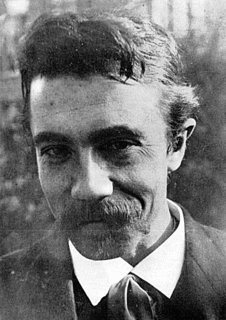
Louis Marie-Anne Couperus was a Dutch novelist and poet. His oeuvre contains a wide variety of genres: lyric poetry, psychological and historical novels, novellas, short stories, fairy tales, feuilletons and sketches. Couperus is considered to be one of the foremost figures in Dutch literature. In 1923, he was awarded the Tollensprijs.
Dutch-language literature comprises all writings of literary merit written through the ages in the Dutch language, a language which currently has around 23 million native speakers. Dutch-language literature is the produce of Netherlands, Belgium, Suriname, the Netherlands Antilles and of formerly Dutch-speaking regions, such as French Flanders, South Africa, and Indonesia. The Dutch East Indies, as Indonesia was called under Dutch colonization, spawned a separate subsection in Dutch-language literature. Conversely, Dutch-language literature sometimes was and is produced by people originally from abroad who came to live in Dutch-speaking regions, such as Anne Frank and Kader Abdolah. In its earliest stages, Dutch-language literature is defined as those pieces of literary merit written in one of the Dutch dialects of the Low Countries. Before the 17th century, there was no unified standard language; the dialects that are considered Dutch evolved from Old Frankish. A separate Afrikaans literature started to emerge during the 19th century, and it shares the same literary roots as contemporary Dutch, as Afrikaans evolved from 17th-century Dutch. The term Dutch literature may either indicate in a narrow sense literature from the Netherlands, or alteratively Dutch-language literature.

Willem Johannes Theodorus Kloos was a nineteenth-century Dutch poet and literary critic. He was one of the prominent figures of the Movement of Eighty and became editor in chief of De Nieuwe Gids after the editorial fracture in 1893. He was nominated for the Nobel Prize in Literature five times.

Frederik Willem van Eeden was a late 19th-century and early 20th-century Dutch writer and psychiatrist. He was a leading member of the Tachtigers and the Significs Group, and had top billing among the editors of De Nieuwe Gids during its celebrated first few years of publication, starting in 1885.

Lodewijk van Deyssel was the pseudonym of Karel Joan Lodewijk Alberdingk Thijm, a Dutch novelist, prose-poet and literary critic and a leading member of the Tachtigers. He was a son of Joseph Alberdingk Thijm.
This article deals with literature written in Dutch during the 19th century in the Dutch-speaking regions.
De Nieuwe Gids was a Dutch illustrated literary periodical which was published from 1885 to 1943. It played an important role in promoting the literary movement of the 1880s. Its contents covered a wide range of topics, extending to developments in science.

Albert Verwey was a Dutch poet belonging to the "Movement of Eighty". As a translator, staffer, and literary historian he played an important role in the literary life of The Netherlands in the late 19th and early 20th centuries.

Jan Pieter Veth was a Dutch painter, poet, art critic and university lecturer. He is especially noted as a portrait painter. Amongst his sitters were Max Liebermann, Lambertus Zijl, Frank van der Goes, Antoon Derkinderen and other contemporaries including various fellow painters.

Willem Witsen was a Dutch painter and photographer associated with the Amsterdam Impressionism movement.

Marcellus Emants was a Dutch novelist who was one of the few examples of Dutch Naturalism. He is seen as a first step towards the renewing force of the Tachtigers towards modern Dutch literature, a movement which started around the 1880s. His most well-known work is A Posthumous Confession, published in 1894, translated by J. M. Coetzee.

Van Vloten is a Dutch patrician family from Vleuten.

Henriette Goverdine Anna "Jet" Roland Holst-van der Schalk (1869–1952) was a Dutch poet and council communist. She was nominated for the Nobel Prize in Literature.

Ecstasy: A Study of Happiness is a novel written by Louis Couperus and published in 1892 by L.J. Veen in a first edition of 1,250–1,500 copies. A second edition was printed in 1894 and a third in 1905. Ecstasy was the first book of Couperus that was published by L.J. Veen, later his regular publisher. Couperus received a wage of 550 guilders for the first edition. Ecstasy was first published in the Dutch literary magazine The Gids. The book was translated into English by Alexander Teixeira de Mattos in 1919 and published by Dodd, Mead and Company.

Stéphanie Hélène Swarth (1859-1941) was a prolific Dutch poet active from 1879 to 1938. She is considered one of the Tachtigers and acquired a reputation as a sonneteer.

Johann Eduard Karsen was a Dutch Post-impressionist painter, known for his moody scenes featuring villages and farmhouses; usually containing a solitary figure. He was associated with the literary movement known as the "Tachtigers".

Augusta Guerdina Peaux was a Dutch poet. She began her publishing career as a writer of prose fiction, in literary magazines and in one collection, and in the early 1900s started publishing poetry, in magazines associated with the literary movement known as the Tachtigers, with whom she became associated. With her sister Johanna, she translated poetry by Dante Gabriel Rossetti and Algernon Charles Swinburne, and with her friend Truus, with whom she shared a love for Iceland and its literature, she translated stories from the Edda. Two volumes of her poetry were published; she never sought literary fame, though some fame came to her posthumously.

Jacques Fabrice Herman Perk was an important Dutch poet of the late 19th century, who died young. His crown of sonnets Mathilde, published by Willem Kloos, was the first important announcement of a renewal in Dutch poetry brought about by artists that came to be known as the Tachtigers. Perk's lyrical poems about nature, especially his sonnets, were influenced by Percy Bysshe Shelley, and were of great importance to Dutch poetry.

Aart van der Leeuw was a Dutch writer of prose fiction and poetry. His reputation rests mostly on two novels, Ik en mijn speelman (1927) and De kleine Rudolf (1930).
















